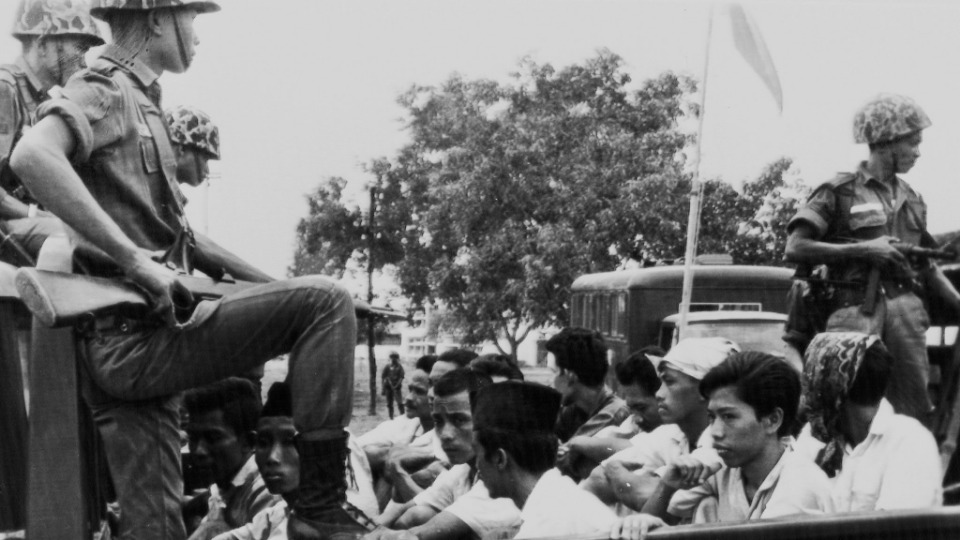
U.S imperialism was on a roll in the mid-20th century as Cold War problems were emerging. These included U.S.-Soviet conflict, nuclear-war fears, the Korean and Vietnam wars, domestic anti-communism, and Indonesia.
Having thrown off Dutch colonial rule, that country led by President Sukarno was in the vanguard of nations striving to steer clear of both the U.S. and socialist camps. The Communist Party of Indonesia (PKI), with three million members, had become the world’s third-largest such party. It participated in elections, was represented in the legislature, and had ties with labor unions and social and cultural organizations.
In a plot of obscure origin, six Indonesian Army generals were murdered on Sept. 30, 1965. Blame fell on the PKI, and soon soldiers, paramilitaries, and thugs were killing or disappearing members of the party and its affiliates. Army General Suharto assumed dictatorial powers, which he retained until 1998. President Sukarno was sidelined. Deaths approached one million; a million more people ended up in concentration camps. Torture was rampant.
In his book The Jakarta Method, journalist Vincent Bevins reports the U.S. government as having supplied equipment and funding to the Indonesian Army and inserting CIA operatives. The latter provided the killers with lists of real and imagined Communists. U.S. officials conditioned U.S. military support on protection of U.S. oil installations and elimination of the PKI.
The PKI was destroyed and communism banned. Bevins claims the U.S. government worried even more about the PKI than about Vietnamese Communists. Later, the pain of eventual U.S. defeat in Vietnam would at least be somewhat mitigated due to eradication of the PKI
Reporting on events in Indonesia, U.S. National Security Advisor McGeorge Bundy, quoted in the book, spoke of “a striking vindication of U.S. policy toward that nation.” New York Times columnist James Reston celebrated events there as “A Gleam of Light in Asia.”
The Jakarta Method surveys “U.S.-backed anti-communist extermination programs [that] carried out mass murder in at least 22 countries.” Bevins reports on killings in Iraq, Iran, Sudan, and especially in Latin America, beginning with Guatemala in 1954. There, a regime imposed by a CIA-instigated coup murdered at least 2,000 suspected Communists.
Brazil’s propensity for rabid anti-communism set the stage for a military coup in 1964. The U.S. government was on the scene already. The military dictatorship replacing President João Goulart lasted until 1985. Brazil “would soon play a crucial role in flipping other countries into the Western camp,” according to Bevins.
The Brazil coup provided a blueprint for the coming disaster in Indonesia. The catastrophes in both countries were models for mass killings that would follow. U.S. involvement was a factor in all of them, although the various assaults gained plenty of inspiration and resources from local sources. Leftist insurgencies active in a few of the countries served as pretexts.
With U.S. help, military dictatorships taking power in Argentina (1976) and Chile (1973) launched the regional killing-machine Operation Condor. Some 75,000 people were murdered in El Salvador. Guatemala’s CIA-assisted military killed 200,000 mostly Indigenous people between 1978 and 1983. The book offers specifics on U.S. involvement in Chile, Nicaragua, and Brazil, but not in other Latin American countries.
In many places, to whisper “Jakarta” or scrawl the word on public surfaces served as a warning, reports Bevins. Setting the tone, El Salvador’s General Roberto D’Aubuisson declared, “You can be a Communist…even if you don’t personally believe you are a Communist.”
Close relationships between U.S. military officers and counterparts in Indonesia and Latin America furthered U.S. military interventions. The U.S. Army’s School of the Americas promoted such interpersonal ties, according to the protest group School of the Americas Watch. The training provided many Indonesian military officers at the Leavenworth, Ks., Army base undoubtedly enhanced their trust, too, in U.S. military personnel at work in their own country.
Bevins notes that Indonesia “likely fell off the proverbial map because of the events of 1965-1966.” Indeed, “faraway countries that are stable and reliably pro-American do not make headlines.” Colombia, another country notable for humanitarian disaster, a brutal civil war, and U.S. intervention likewise receives little U.S. media attention.
Journalist Bevins served long stints in Brazil and Indonesia. Developing personal connections with survivors of the various bloodbaths, he tracked them down throughout the world. What he learned contributes to the authenticity and immediacy of his story. His fact-filled narrative flows on the strength of clear language and commentary along the way.
Bevins declares that “the creation of a monstrous international network of extermination…played a fundamental role in building the world we all live in today…. [V]iolent anticommunism still exists in Brazil, Indonesia, and many other countries. The Cold War created a world of regimes that see any social reform as a threat.”
He sheds new light on the nature of the Cold War. For Bevins, “What happened in Brazil in 1964 and Indonesia in 1965 may have been the most important victories of the Cold War for the side that ultimately won.” He points out that his “story of the Cold War [isn’t] focused primarily on white people in the United States and Europe,” or in the Soviet Union.
The Jakarta Method surveys a string of separate armed conflicts inspired by anti-communism. They took place within different countries. Armed agents of the top layers of each of these societies were attacking fellow citizens who were, or thought to be, seeking justice and empowerment. In essence, the book deals with class conflict in these countries.
The author’s agenda wasn’t about a Cold War fought with words and posturing between some nations governed by Communist parties and others that were powerful and anti-communist. That Cold War ended with the fall of the Soviet Bloc of nations in 1991. The other one, not really a cold war, is quiescent now, but it continues.
The Jakarta Method
By Vincent Bevins
PublicAffairs, New York, 2020
307 pp., $28










